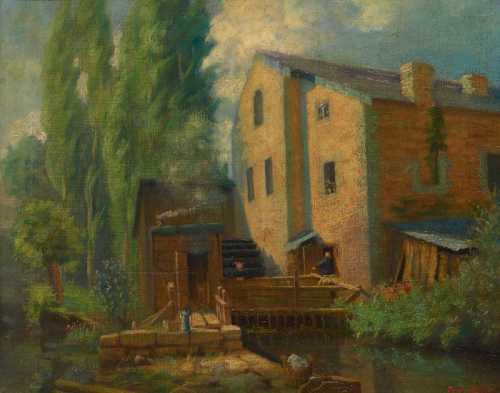About Abolhassan Sadighi
Abolhassan Sadighi is a painter, teacher, and father of modern and professional sculpture in Iran. One of Kamal-ol-Molk's students and a student at Sanaye Mostazrafeh Art School. Sadighi was from a wealthy family, and his mother's lineage reached the Qajar princes. At the same time as his primary education at Alliance School, he became interested in painting and learned painting by himself. His studies at this school were interrupted halfway and he began art education at Sanaye Mostazrafeh Art School with his friend Mohammad Ali Heidarian. After three years of art education, he earned a first-class diploma in art. In the meantime, he started sculpting as a self-taught artist and progressed with the help of a book about the principles of sculpting that Kamal-ol-Molk gave him. Having completed the study course at Sanaye Mostazrafeh Art School, he moved to France in 1928. There, he studied sculpture for four years at Bouzard in Paris under his teacher Albange. During this time, besides sculpting, he also painted with oil and watercolors. After finishing his education, he returned to Sanaye Mostazrafeh Art School, this time as a teacher, and took charge of the management of this school. With the establishment of the Faculty of Fine Arts, he taught sculpture at this university. In 1950, he became a National Art Works Association member and made sculptures of Iranian celebrities under its programs. Figures of Saadi, Hafez, Ferdowsi, and Ibn Sina are the result of this period of his work. The statue of Ferdowsi in Ferdowsi Square in Tehran, the statue of Yaqub Leith riding a horse in the central square of Zabul city and the statue of Amir Kabir in front of his house in the current Mellat Park are among his works of celebrities.
Unlike many of Kamal-ol-Molk's students, Sadighi showed considerable effort to improve the quality of his work. In painting, he soon turned to brilliant colors and free brush strokes. In sculpture, he consciously replaced the principles of Neoclassicism with naturalism and achieved novel results in character visualization. The deepening of his visual language and his mastery of the material can be clearly recognized by comparing the black plaster statue of Reed player (1926) and the bronze memorial of Nader Shah (1956). As a teacher, he also played an influential role in training Iranian sculptors. Ali Akbar Sanati was one of his first students.
Unlike many of Kamal-ol-Molk's students, Sadighi showed considerable effort to improve the quality of his work. In painting, he soon turned to brilliant colors and free brush strokes. In sculpture, he consciously replaced the principles of Neoclassicism with naturalism and achieved novel results in character visualization. The deepening of his visual language and his mastery of the material can be clearly recognized by comparing the black plaster statue of Reed player (1926) and the bronze memorial of Nader Shah (1956). As a teacher, he also played an influential role in training Iranian sculptors. Ali Akbar Sanati was one of his first students.
The Most Expensive Artwork
At Auctions
First Attendance
29 May 2015
# Attendance
3
# Artworks
3
Average Realized Price
15,405 USD
Average Min Estimate
13,211 USD
Average Max Estimate
18,543 USD
Sell-through Rate
100%
Average Growth of Artwork Worth
-1.111%
Timeline
The 9th Tehran- Classic and Modern Iranian Art auction
29 June
پنجمین دوره حراج تهران auction
27 May
چهارمین دوره حراج تهران auction
29 May
